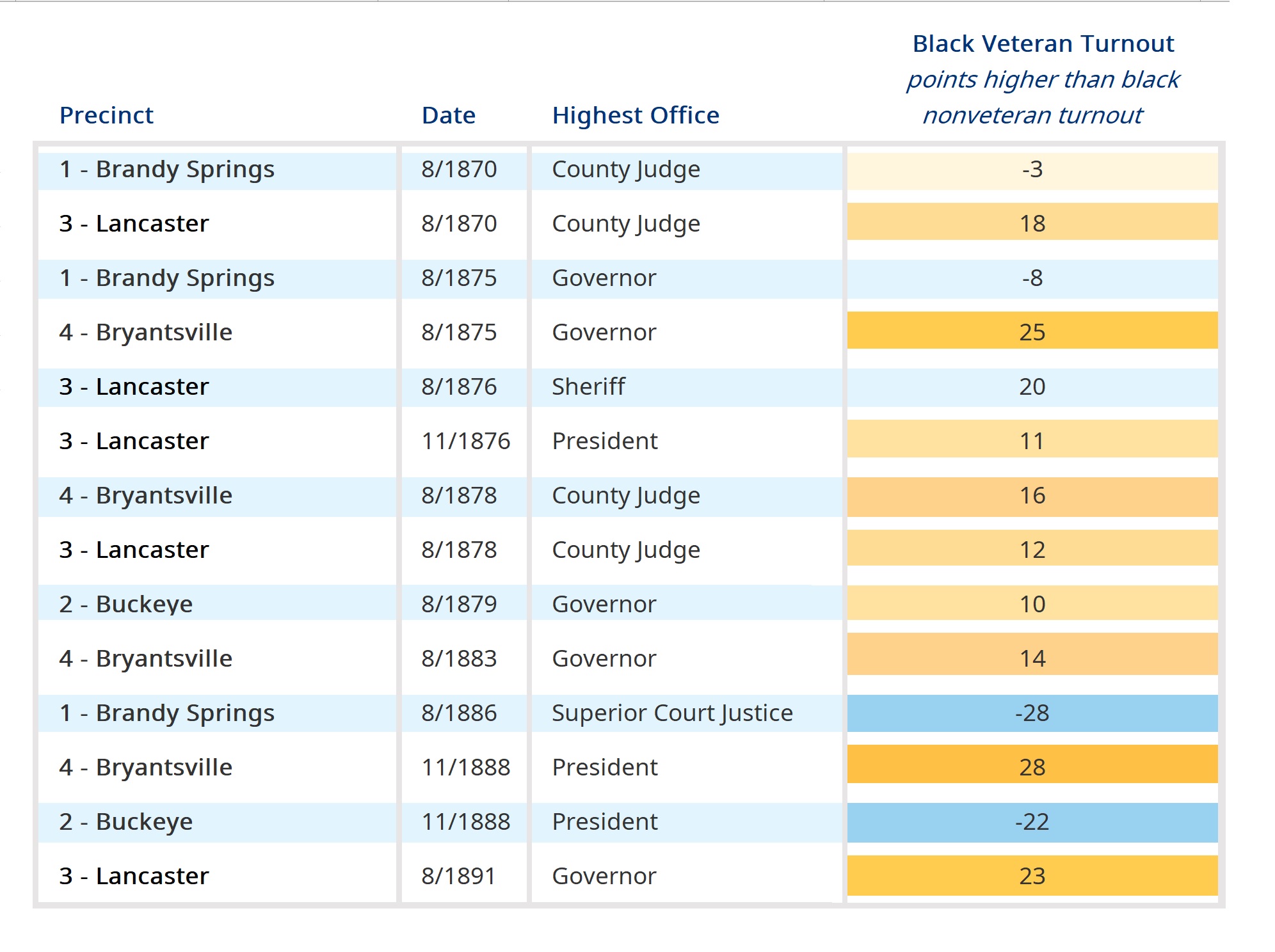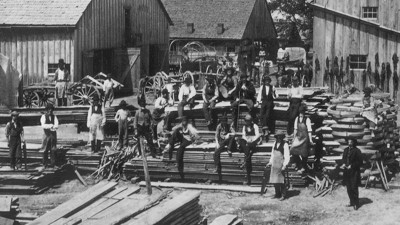

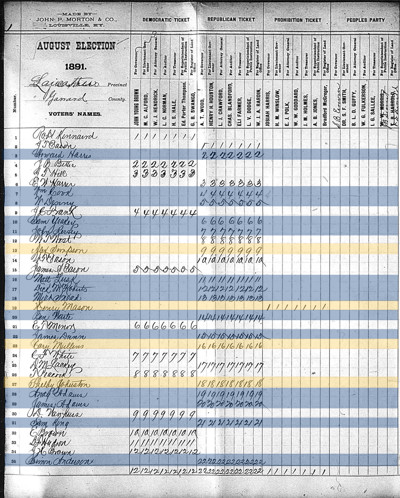
First page of Lancaster 1891 poll book showing black veterans, Alexander Simpson, Henry Mason, Cary Mullins, and Shelby Johnson in yellow and other black voters in blue.
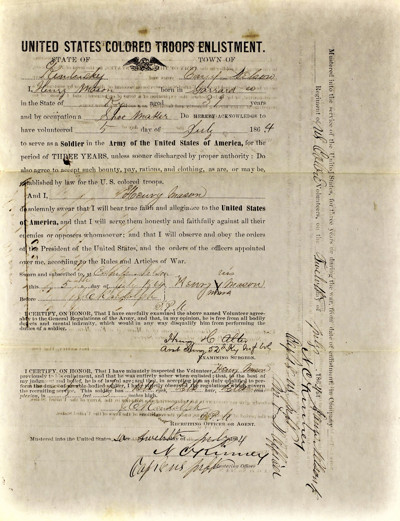
Private Henry Mason’s U.S.C.T. enlistment papers.
National Archives, Civil War Service Records, Colored Troops.
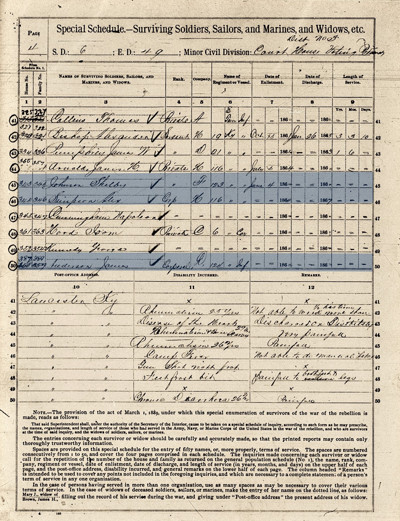
A page from the 1890 U.S. Census of Civil War Veterans showing Shelby Johnson, Alexander Simpson, and James Anderson.

An 1865 U.S. Colored Troops recruitments poster published by the Supervisory Committee For Recruiting Colored Regiments.
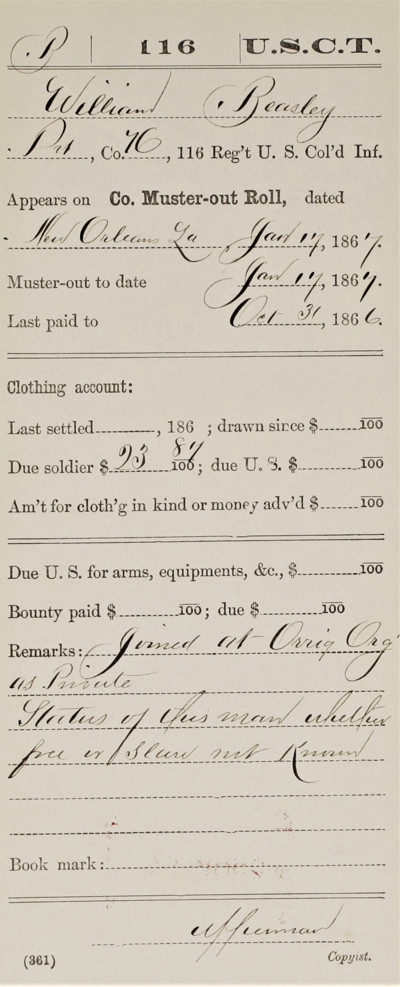
Private William Beasley’s mustering out papers from 1867 showing the amount he was paid upon mustering out.
National Archives, Civil War Service Records, Colored Troops.
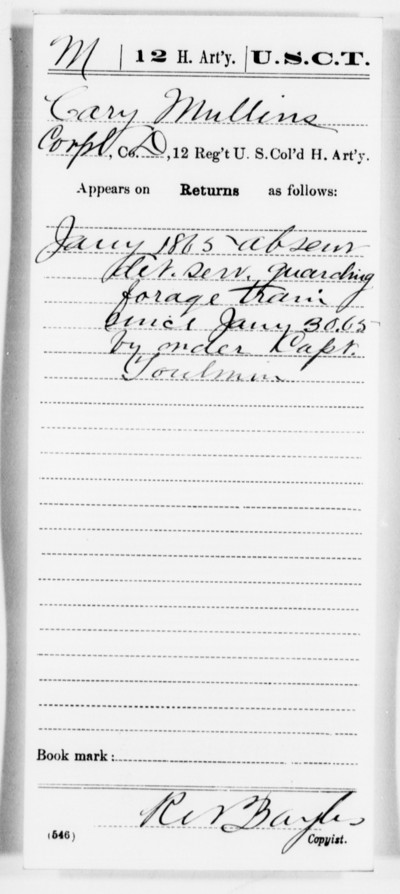
USCT return showing Corporal Cary Mullins’ detachment to guard cattle in 1865.
National Archives, Civil War Service Records, Colored Troops.

USCT return showing Private Bob Faulkner’s detachment to guard cattle (“forage”) in December 1864.
National Archives, Civil War Service Records, Colored Troops.
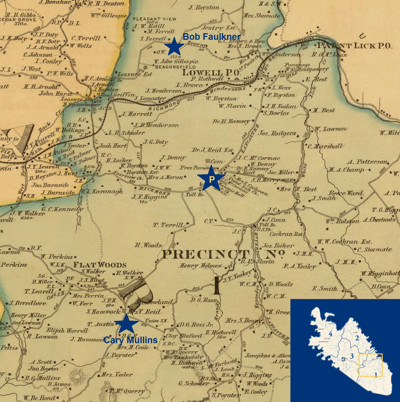
Detail from the 1879 Beers and Lanagan Land Ownership Map of Garrard and Lincoln counties showing the Brady Springs precinct. The estimated places where Cary Mullins and Bob Faulkner, who served together in Texas, lived relative to the precinct polling place.
University of Wisconsin-Milwaukee Libraries.
Bonds Forged by Military Service:
Black Veterans more likely to vote and vote together
When Henry Mason turned out at the Lancaster courthouse to vote for governor, a range of other state and local officials, and a new state constitution on August 3, 1891, he did so among fellow Union veterans who had been stationed with him at Camp Nelson more than a quarter of a century earlier. He declared his support for the Prohibition Party ticket and the new constitution that summer’s morning, voting aloud for the last time. It was the last time Garrard County would vote viva voce before the new Kentucky constitution, approved in that very election, took effect in 1892 and replaced viva voce with the secret ballot.
Still voting together in 1891
The polls opened at 6am, 45 minutes after sunrise. Mason arrived at the courthouse in the first group of black voters that summer’s day. They were mostly neighbors, from the southwest corner of town.
Many of them were also veterans.
Corporal Alexander Simpson cast the thirteenth vote of the day. Private Mason, a retired boot maker, cast the 19th vote of the day. Mason and Simpson served together at Camp Nelson, less than 15 miles north of the Lancaster courthouse. Mason and Simpson both enlisted in July 1864. Both served among about 100 men in Company H of the 116th Colored Infantry until September 1864, along with another voter in their group, Rice Hyatt.
The 116th Colored Infantry headed out to Virginia to take part in the Richmond–Petersburg campaign, including the Breakthrough at Petersburg on April 2, 1865, which was a decisive blow to the Confederates and led to the surrender of General Robert E Lee at Appomattox just one week later.
Astoundingly, 26 years later, these three men voted together at the Lancaster Courthouse.
A few voters after Simpson, Private Cary Mullins declared his vote. Mullins had enlisted as a 17-year-old in the 13th Heavy Artillery, probably escaping from his owner and enlisting for his freedom in May 1865. He served in the 13th Heavy Artillery at Camp Nelson. Mullins was followed, a few voters later, by Shelby H. Johnson, who had served 123rd Colored Infantry out of Louisville. United States Colored Troop veterans were out in force, expressing their views on the Kentucky gubernatorial race and whether to adopt a new Kentucky constitution.
United States Colored Troops
Around 25,000 black men enlisted in the Union Army in Kentucky, as many as any other state and 13 percent of the entire United States Colored Troops (USCT).
These men enlisted for all sorts of reasons, including at the direction of their owners (who were able to enlist one of their slaves in place of a drafted son and receive a $100 bounty from the federal government in Washington for doing so). But number one among their reasons was undoubtedly to gain their freedom. From February 1864, enslaved black men in Kentucky could independently enlist in the Union Army so long as they had their owners’ consent. Upon enlisting, these men escaped servitude and hoped to gain their freedom.
From June 1864, enslaved men who escaped their owners became able to enlist. However, they did not gain their freedom upon enlistment like other black soldiers. Soldiers like James Anderson, who fled from slavery and enlisted without his owner’s consent, and Henry Mason did not win their freedom upon enlistment. For Anderson, and others who escaped their owners, freedom would not formally arrive until December 1865, when the 13th Amendment was ratified.
The Contradictions of Camp Nelson
Most of the veterans who settled in Garrard County after the war had been stationed at Camp Nelson, just a few miles north of Lancaster. Their time at Camp Nelson was one of contradictions. Freedom, camaraderie, income, respect, routine, and the forging of lifelong bonds with other soldiers. Excitement and drama when the Camp was on high alert for a threatened Confederate attack. But they also encountered fierce racism and discrimination. And, until June 1864, black soldiers were paid little more than half as much as white soldiers of the same rank.
Planned and built in 1863 as a secure supply depot and recruitment center, Camp Nelson was initially intended for white soldiers, but became the Union Army’s third largest black recruiting center. Over 13,000 black American men enlisted in the USCT at Camp Nelson, whether presented by their owner or as a fugitive from slavery. Between 3,000 to 8,000 soldiers were stationed at Camp Nelson at any one time. It was like a large self-contained city, with its own hospitals, reservoir, prison, warehouses, and bakery. Indeed, at times Camp Nelson was the fourth largest city in Kentucky and it was one of the largest gatherings of African Americans in the United States.
Camp Nelson also became a major refugee center for displaced black women and children. Military leaders resisted the presence of women and children, many of them family of enlistees. In August 1864, the Camp Commandant ordered the expulsion of black women and children. Some left, many returned, and more arrived. In November, as the Camp mobilized to support an Army and Cavalry raid into Virginia, the Camp Commandant expelled 400 black women and children. They were expelled at bayonet point, many without shoes, in weather so bitter that a quarter died. White soldiers burned their shelters and any possessions left behind. Black soldiers were not told how or where to find their families and it is likely some were never reunited with their wives and children.
In their time at Camp Nelson, black men were part of a vastly different world than the one they lived in before military service. When they left the army, they once again found themselves in a new world. Yes, they were free, but they were also often homeless and almost always propertyless except for the army pay they collected as they mustered out. They faced the daunting challenge of reuniting their families and building a life alongside former slave owners and supporters of the Confederacy.
Newly enfranchised veterans were very politically active
Using government records, we were able to identify over 100 black Union veterans who returned to Garrard County after the Civil War. These men were the crux of black participation in Garrard County, especially in Lancaster.
In Lancaster, 9 in 10 black Civil War veterans voted in the first election in 1870, a higher turnout rate than for other veterans and the rest of the population. Black veterans remained more engaged citizens even 20 years later, voting at rates 50% higher than other black men who were of age during the Civil War in the 1891 gubernatorial election.
Bonds forged during the war permeated political participation, with veterans of the same company heading to the polls together.
Private Bob Faulkner and Corporal Cary Mullins served together in Company D of the 12th Heavy Artillery, mustered in at Camp Nelson but soon sent on a mission to guard the passage of federally owned cattle to Nashville in the latter part of 1864. They both returned to Garrard County after the war, settling in the eastern part of the county known as Brandy Springs. Early in the morning of the first election in which African American men could vote, they headed together to the polls in Brandy Springs precinct to declare their vote, one after the other, for the Republican candidates.
In Lancaster, more veterans from the 12th Heavy Artillery turned out to vote together. Voting in the middle of the day, George Denny Sr voted with fellow 12th Heavy Artillery veteran George Walker and other Camp Nelson veterans. During the war, Denny Sr. was part of Faulkner and Mullin’s team, guarding the passage of cattle in Tennessee. (Before the war, George Denny Sr. had been owned by James G. Denny, who was, at most, distantly related to Judge George Denny Jr., the Republican judge candidate in this election.)
It was not only members of the 12th Heavy Artillery who brought their bonds home. William Dunn, who had been owned by one the largest slaveholders in the county, served with William Beasley at Camp Nelson in Company H of the 116th Colored Infantry (along with Henry Mason, Alexander Simpson, and Rice Hyatt). They signed up on the same day: July 6, 1864. After defending Camp Nelson against a threatened Confederate attack and taking part in the Richmond–Petersburg campaign, Beasley and Dunn went with their Company to Texas and were eventually mustered out of service in January 1867, in New Orleans, where their status as slave or free was unclear. They both made the 700-mile journey back to Garrard County and headed to the polls together on August 1, 1870, voting for the Republican candidates.
There are hundreds of these stories over 20 years of black veterans settling to Garrard County and heading to the polls together. And these stories are reflected in turnout figures in the table below.
In the final viva voce election at the Lancaster courthouse, in August 1891, turnout of black veterans was more than 50% higher than turnout of other black men who were old enough to have served in the Civil War. In all, at least 25 black veterans including James Anderson, Mason, Simpson, Hyatt, Private Mullins, and Johnson, orally expressed their view for the candidates for governor, other state executive offices, and to adopt a new constitution. Anderson, Mason, Simpson, Hyatt, Mullins, and Johnson all voted in favor of the new constitution, which would end voice voting in Kentucky and replace it with the secret ballot. Perhaps none realized that the secret ballot would amount to a literacy test, disenfranchising men, like themselves, who could not read.
GARRARD COUNTY, 1870-1891 Black Veteran and Non-veteran Turnout in Garrard County
